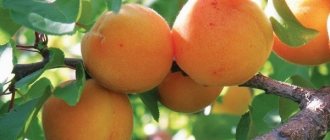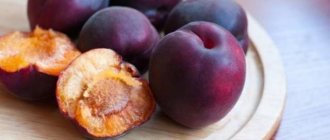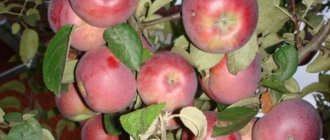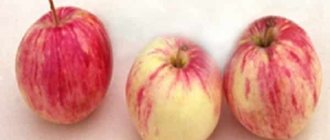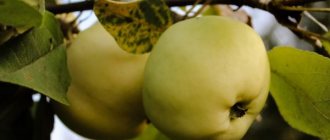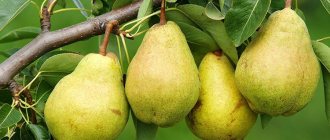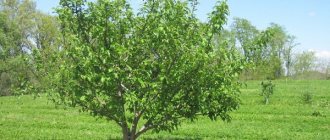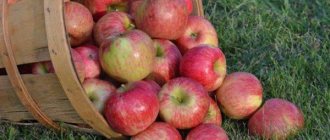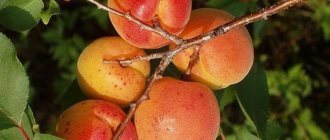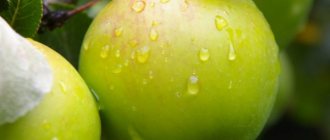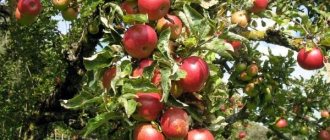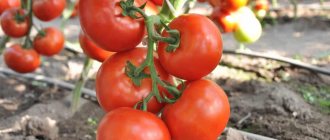Characteristics of wood
Before planting, you must read the description of the Shalah apricot. The tree can be considered medium-sized, since its height is no more than 2 m. The growth rate is moderate. The annual growth is about 25-35 cm in height.
Shalah - a variety of apricot with aromatic and tasty fruits
The crown of the tree is not very dense, but at the same time round and wide. It is thanks to this that the crown thinning will not have to be done too often. Apricot branches are most often curved. They are quite thick and large. The branches are covered with large, green, heart-shaped foliage.
At the end of May and the first half of June, small flowers appear on the trees. Their diameter reaches 3 cm. They bloom for a short time - only 1-2 weeks.
Description of the Shalah variety
The tree is of medium size, the crown is wide, rounded, but not dense, so the thinning of the branches inside is carried out very rarely, usually the formation concerns only the outer part of the crown. The branches are large, thick, curved. The flowers are not small, cream with a light pink tint. The leaves are heart-shaped, green.
The fruits of the Shalah apricot are large, each weighing between 50-60 grams
The fruits of the Shalah apricot are large, each weighing between 50-60 grams. The color is yellow, there is a red blush, but not often. The shape is always only oval. The pulp is yellow-orange, much brighter than the peel, fleshy, dense. The taste is pleasant, slightly sour, but more sweet and very aromatic.
Description of fruits
Chizhovskaya pear: description of the variety, pollinators, when it ripens
Closer to mid-summer, the first fruits begin to appear on the branches of the Armenian variety. After ripening they become quite large. One ripe apricot can weigh about 100-120 g. Their shape is ovoid; oval apricots are less common. The ventral suture is clearly visible on the surface of the fruit. The skin is smooth, with minor tubercles. The color of the surface of ripened fruits may vary. The most common apricots are orange in color with a slight reddish tint.
Additional Information! The pulp has a very pronounced taste.
It is quite sweet and juicy, with a slight sour taste. Some ripe apricots have a faint pineapple aroma.
Harvesting and processing
The fruits ripen around mid-July, and fruiting lasts approximately 7-10 days. You shouldn't keep apricots on the branches for too long - after they get overripe, they quickly fall off, so the harvest is usually harvested on time.
It is recommended to eat Shalah apricots fresh.
It is recommended to consume Shalah apricots fresh. They also tolerate heat treatment well. If you seal them whole in jars, you will notice that the pieces do not fall apart. You can get good jam, marmalade, compotes and even preserves from this variety, but only if you find a good recipe. If there is a lack of sugar, the preservation will be bland, the taste of the apricots will be unexpressed.
Disadvantages and advantages
Apricot Northern Triumph: variety description, planting and care
Gardeners planning to plant Shalah on their plots should know its advantages and disadvantages. Among the main advantages of the variety are the following:
- Productivity. With proper care, each planted tree can ripen 80-100 kg of fruit.
- Frost resistance. This variety is not afraid of frost, so in winter it feels great in open ground both in the Middle Zone and in the North.
- Disease resistance. Shalah almost never suffers from fungal diseases.
High yield is one of the main advantages of the variety
The disadvantages of the variety include:
- Productivity largely depends on the weather.
- Falling of overripe apricots.
- Slow maturation.
Description of the tree
The trees bear fruit 3–4 years after planting. The variety stands out for its regular yield. The first ripening is late.
Apricot Shalah is a mid-season variety. Technical ripeness of the fruit occurs at the end of July and the first half of August. The variety will not ripen evenly and therefore harvesting may take 2–3 weeks.
Description of the apricot variety Shalah:
- drought resistance;
- resistance to low temperatures;
- cross pollination;
- resistance to diseases: clasterosporiosis, leaf curl, moniliosis.
In warm regions, flowering begins in the first half of June. Unfavorable weather conditions may delay development by 2–3 weeks, but then the fruits will ripen later. The diameter of the flowers ranges from 2.5 to 3 centimeters. Snow-white petals are elongated or round in shape.
White apricot is not able to pollinate on its own, so the tree is planted next to other fruit crops. Gardeners say that the volume of the harvest and the taste of fruits will only improve from proximity to cherry plums, peaches and other types of apricots.
Fruit characteristics
The fruits of Lemon apricots are large: one fruit weighs 80–100 grams. Shape: oval or ovoid. The ventral suture is clearly defined. Lumps can be felt on the skin. The color of the fruit ranges from yellow to bright orange with a red blush on the sides.
Fruits with a matte, velvety surface. The skin is dense, so fruits that fall to the ground do not break. The pulp has distinct taste characteristics: sweet, juicy, with notes of sourness and a light pineapple aroma. The stone is easily separated from ripe fruit.
This is interesting! The damage to apricots lies in their pit. It contains a large amount of acids, which are poisonous to the body. The fruits should be consumed with caution by people with gastrointestinal diseases and diabetes. Otherwise, instead of benefits, there will only be problems.
Productivity
Shalah produces abundant harvests. One tree produces from 100 to 200 kilograms of fruit. Under good weather conditions and particularly careful care, the figure can increase to 350–400 kilograms.
Apricot is resistant to frost - up to -25 degrees. Therefore, the variety is not recommended for growing in Siberia and other regions with harsh winters. An exception is covering trees for the winter (greenhouses).
Resistant to fungal diseases and pests. Does not require careful care.
Choosing a landing site
Before you start planting, you need to select a suitable growing area. Gentle slopes are considered the ideal place for apricots and other stone fruits. The location chosen for growing trees should not be too windy. Strong gusts of wind can break branches or knock off fruit.
When gooseberries ripen: how to pick ripe berries
The soil must be fertile and contain sufficient nutrients. Areas with sandy-loamy soil are suitable for apricots.
Important! Apricot trees should not be planted in soils that are too acidic. The acidity level should not exceed 7 pH.
Characteristics
Before purchasing Shalah apricot seedlings, it is important to carefully study all the features of the variety. This will help ensure proper care of the crop, and most importantly, normal growth and development of plants.
Drought resistance, winter hardiness
The Shalah variety is characterized by a high level of drought resistance. Despite this, trees cannot develop normally from rainwater alone: apricots need regular watering, especially during the flowering period.
The Shalah variety is quite winter-hardy and can tolerate frosts down to -25 °C. This indicator is optimal for the southern regions, however, when grown in the north, trees will require additional protection.
Pollination, flowering period and ripening time
Apricot Shalah is classified as a self-sterile variety. To maintain productivity, it needs pollinators (apricot, peach) with identical flowering periods.
This is an early variety, but the time of collection directly depends on the climate of the area where the tree grows. In Armenia and other southern regions, Shalah ripens in early June and immediately appears on local shelves. In regions of the middle zone, such as the central Black Earth Region, the harvest is carried out at the end of June or at the beginning of July (depending on weather conditions).
The tree ripens completely, but the lower branches may lag a little, which is why the fruits are collected from them a couple of weeks later
For commercial use, it is better to harvest the fruits at the stage of technical maturity. If apricots are grown for consumption, then it is better to leave them until final ripening. Then the pineapple taste and aroma will fully appear.
During the flowering period, large inflorescences (up to 3 cm) in size with white petals of a pinkish tint appear on the branches. On a tree under 4 years old, it is recommended to shake off the flowers so that it becomes stronger and produces a rich harvest.
Productivity, fruiting
Apricot Shalah is characterized by a high level of productivity. From one tree you can collect up to 150-200 kg of fruit per season. Under favorable weather conditions and proper care, this number can reach 350-400 kg. It is better to collect fruits by hand, especially for fresh consumption. The fruits are quite easy to remove: you just need to shake the tree and the fruits will fall to the ground.
It is better to harvest in dry weather; 5-7 days are often enough for this. Apricots are placed in cardboard or wooden boxes. To increase the shelf life of fruits, napkins can be placed between the fruits.
Area of application of fruits
The fruits of the Shalah variety have an average level of sweetness and excellent taste. A small orange seed is easily separated from the pulp.
Apricots themselves are consumed both fresh and in the form of dried fruits, canned food, in baked goods or salads. Ripe fruits are used for preparations: jams, apricots, dried apricots, etc.
In the South Caucasus, this variety is traditionally used in the field of canning production
In addition to excellent taste, Shalah apricots have many beneficial properties for the human body. Thus, it is recommended to use them in dried form for people with cardiovascular diseases. Apricots of this variety also help strengthen the immune system and improve skin condition.
However, doctors do not advise people with diabetes to consume the fruit due to the high sugar content in the product.
Resistance to diseases and pests
One of the main advantages of the Shalah variety is its high resistance to the main diseases of stone fruit trees.
The crop is especially resistant to moniliosis, clasterosporia, and leaf curl.
In order to prevent pest damage to the tree, it is enough to carry out regular treatment with standard protective agents.
Advantages and disadvantages
The Shalah variety is able to quickly recover after freezing.
Thanks to late flowering, the likelihood of frost damage to the tree is reduced.
Advantages:
- high level of resistance to moniliosis, leaf curl and clasterosporiosis;
- self-fertility of the culture;
- resistance to frost and dry weather;
- high yield of the variety.
Flaws:
- if the fruits are overripe, this leads to a deterioration in their taste, and the pulp becomes fibrous;
- ripe apricots may fall off earlier;
- short storage period (up to 7 days);
- If water stagnates in the root system, the crop quickly becomes ill and dies.
How to plant an apricot: planting from a seed
Most often, gardeners grow apricot trees from planted seeds.
The planting hole must be deep and wide enough
The planting process consists of several stages:
- Planting seeds. They need to be planted in a small pot filled with a soil mixture of soil and peat. After 3-4 months, a seedling will grow from the seed, which can be transplanted into open ground.
- Preparing the planting hole. It is necessary to prepare the hole in which the seed will be planted 15 days before planting on the site. Its depth should be 50-60 cm, and its width 40-50 cm. The bottom of the hole should be filled with a small amount of crushed stone, which will act as drainage.
- Soil preparation. In order for the apricot to immediately begin to grow well, it must be planted in a properly prepared soil mixture. To do this, you need to mix 2 parts of soil with 1 part of peat. You can also add some phosphorus and nitrogen fertilizers.
- Landing. When the hole and soil mixture are prepared, you can begin planting. The soil needs to be slightly moistened with warm water, after which germinated apricot seedlings can be planted in it.
Important! Immediately after planting, it is necessary to dig a peg near the tree to which the apricot will be tied.
Landing Features
Despite the ease of care, the Shalah variety has several planting and cultivation features. Before planting a tree, it is important to carefully read the following nuances.
Recommended timing
The method of planting the Shalah apricot is similar to the Dobele variety. The crop is self-fertile, which is why it is recommended to plant trees in mid-spring or autumn. The best option would be the last days of April or mid-September.
Choosing a suitable location
Apricot Shalah is recommended to be planted in loamy soil with a neutral acidity level. In clayey and heavy loamy soils, crop yields decrease and the tree may die. Apricots must be planted in a sunny area without drafts.
The hole is prepared in August for autumn planting, and for spring planting, the hole is prepared after the snow melts. The size should be 70*70*70 cm. A peg must be inserted into the hole to secure the tree.
What crops can and cannot be planted next to apricots?
Gardeners unofficially call apricot a solitary tree; the crop does not get along well with other fruit trees:
- The apple tree does not directly harm the apricot, but it seriously competes with the crop for nutrition and moisture. A distance of at least 6-8 m must be maintained between trees.
- A pear should absolutely not be planted near an apricot: during the growth process, the stone fruit crop can “strangle” the weaker tree.
- The plum is considered the only representative of stone fruits that can grow without problems near apricots. At the same time, it is important for both crops to provide all the necessary conditions for growth.
- Most stone fruit crops (cherries, sweet cherries, peaches), as well as apple trees, compete with apricots for water and nutrition. In addition, trees are affected by common diseases and pests.
- Raspberries can grow normally next to young apricots. In this case, the shrub plays the role of a powerful nitrogen fixer and prevents the development of some fungal diseases.
Another undesirable neighbor of the crop is the conifer, the litter of which leads to acidification of the soil, which is unacceptable.
Selection and preparation of planting material
It is important that the seedlings are purchased from a trusted place, ideally at the market or nursery. There should be no physical damage to the trees. It is important that the trunk is strong, with bright green leaves.
The height of a seedling with 4 shoots should be 0.6-0.7 m. If there are thorns on the tree, this is a sign of a semi-wild culture; such a specimen is not worth buying.
Landing algorithm
To plant a seedling in the soil, you need to prepare a mixture of peat and ordinary soil in a ratio of 1:2. If desired, you can also add some minerals: potassium, nitrogen and phosphorus.
During planting, the seedling must be positioned so that the root collar is 5-7 cm above the ground level after the hole is completely filled. The soil must be compacted and then the seedling must be tied to the inserted peg. For rapid development, the tree needs to be provided with regular, abundant watering. The first is immediately after planting, so that the water reaches the root tips.
Features of care
Apricot pineapple Shalah will grow well only if it is properly cared for.
Pruning is a procedure that is carried out annually
Trimming
In order for apricot trees to bear fruit better, you will have to prune them regularly. This procedure must be carried out annually in autumn or spring. You need to trim off already dried branches and stems on which fruits do not form.
Crown formation
During crown formation, the plant is pruned at a height of one meter. It is necessary to leave two branches that are directed along the tree. The rest are cut into a ring. The central stem is not cut; it should be 20-30 cm higher than other branches.
Watering
In the first 30-40 days after planting, the tree should be watered at least twice a week. In this case, you need to use water heated to room temperature. Each tree uses a bucket of water.
Whitewash
Whitewashing grown trees is an agrotechnical technique that is used to protect the crown of plants from frost and sunburn. Whitewashing of apricot trees should be done in late spring, in the second half of May.
Top dressing
Fertilizers are applied depending on the condition of the soil. If there are insufficient nutritional components, the branches may wilt. The first feeding is carried out in mid-spring. During this period, nitrogen fertilizers are added to the soil. In summer and autumn, apricot is fed with phosphorus and potassium mixtures.
Care
Caring for the Shalah apricot is not difficult; even an inexperienced gardener can cope with the task. It is necessary to water, whiten, treat for diseases/bugs, and fertilize trees on time. They regularly form a bush, take care of the tree trunk, and prepare for winter.
Apricot pruning Shalah
Crown pruning is the most important procedure for the Shalah apricot variety. The tree is growing rapidly and many new shoots are sprouting. The bush is formed 2 times - in spring and autumn.
To properly trim the crown, cut out the central conductor before branching with shoots, they are shortened by 1/3.
For 2-3 years, it is constantly pruned, stimulating the growth of side branches. 3-4 skeletal shoots are left on the trunk, with the same number of skeletal branches on them. The excess is cut out into a ring. Then a cup-shaped bush is formed, suitable for light-loving apricots. Further, regular monitoring of the number of shoots is required. All intertwined specimens growing inwards must be removed. To prevent the tree from becoming infected with viral pathologies, it is necessary to disinfect the pruning shears and treat the cuts with garden varnish.
Top dressing
Apricot trees are fertilized to stimulate productivity. Nutrient formulations are added every 1-2 months throughout the growing season. The first procedure is done to speed up the blooming of leaves. It is carried out in March, urea and ammonium nitrate are added under the rhizome. In summer, potassium and phosphorus compounds are used for replenishment. They are added 2 times. Every 2-3 years, usually in the fall, apricots are fed with organic matter while plowing the soil.
Watering
Apricot variety Shalah needs to be watered only during the hot season. This is done when the fruits ripen, after the leaves fall. Small trees are irrigated in the trunk area until it is filled, adults - in a ditch dug around the trunk 1 meter from it. The depth of the trench should be 15 cm, width - 20 cm.
Whitewash
Particular attention should be paid to autumn agrotechnical manipulations: the lime mixture is used to destroy harmful insects hidden in the cracks of the bark, to prevent burns of the trunk and shoots. When fertilizing in spring, copper and iron sulfate are added to the solution - slaked lime is diluted with water to the state of liquid sour cream. To the combination add 2 full tablespoons of copper sulfate per 5 liters. This promotes the healing of frost holes and prevents harmful beetles from climbing to the top of the tree along the trunk. It is necessary to whitewash the standard, including the base of the skeletal branches.
Preparing for winter
Apricot Shalah survives winter frosts safely, but experienced gardeners advise protecting it from the cold. As long as the tree is not too large, it can be completely wrapped with synthetic or natural materials such as burlap or polypropylene film. Mature apricots are fertilized with organic matter, the trunks are whitened, and tied with artificial materials or pine branches to protect them from rodents.
See also
Description and cultivation of apricot variety Zhigulevsky Souvenir
Read
Tree trunk circle
Periodically weed the soil around the trees, removing weeds and improving its aeration. After planting the apricots, the tree trunk area is mulched and the procedure is repeated every year. The ground is covered with mulch for the whole year or only for winter or summer to protect the rhizomes from drought and frost. The mulch is laid out tightly, in a layer of 7-10 cm.
Ripening and harvesting
It is recommended to collect shalakh in the first half of August, after the fruits have fully ripened. In this case, it is better to carry out cleaning with special gloves so as not to accidentally damage the fleecy cover. The collected fruits should be placed in several layers in plastic or wooden boxes.
Boxes and crates are ideal for storing apricots in the cellar
Important! You need to pick apricots carefully so as not to accidentally damage them with your hands. Damaged fruits are not suitable for long-term storage.
Description of apricot Shalah: caring for the variety
Shalah is a type of apricot tree that is one of the varieties that ripens in mid-summer. The Shalakh apricot variety is considered by many to belong to our country, but in fact, it originates in the vastness of Armenia.
By the way, this name is not the only one given to this fruit. If there are also such as: Pineapple, Shalagi, Lemon, White and Jewish apricot.
If we talk about popular apricot varieties in Russia, in another article we described the Lel apricot.
Pests and diseases
Some people believe that only pollinating insects fly near apricots. However, in reality, trees can also be attacked by pests. These include:
- aphids;
- leaf roller;
- weevils;
- silkworms.
Aphids are a dangerous pest that often attacks trees.
Trees can also suffer from powdery mildew, cytosporosis, moniliosis and verticillium. To combat them, special drugs are used.
Among apricot lovers, the Shalah variety is popular. Gardeners who want to grow it on their plot and get a good harvest should familiarize themselves with the features of planting this variety and how to care for it.
Description and characteristics of apricot varieties Shalah Pineapple and Tsurupinsky, yield and cultivation
Apricot of the Shalah or Pineapple variety is quite famous among the fruit crops preferred by gardeners.
Apricots are valued not only for their excellent taste, but also for their content of useful substances: vitamins B, A, C, microelements (iodine, iron, phosphorus, potassium and magnesium), tannins, fiber, acids. Apricot (dried dried apricots) is especially useful for people suffering from heart and vascular diseases. Strengthens the immune system, has a beneficial effect on the condition of the skin. It is not recommended for use by patients with diabetes mellitus, as it contains sugar. Breeders threw all their efforts into breeding a variety called Pineapple Tsyurupinsky.
Description of apricot Shalah
The fruits of the Shalah apricot variety appear on the trees already on the fourth day after the tree was planted.
- This type of apricot is good because it always brings a stable harvest. But we remember that the first ripening usually takes a little longer. It is distinguished by its medium ripeness, since the moment of harvesting occurs in July or August. Harvesting can take about two weeks, since apricots do not ripen equally or evenly.
- The Shalah variety has a peculiar ability to withstand dry times.
- Well able to tolerate low temperatures.
- Apricots can be cross-pollinated.
- Very robust for being susceptible to disease. Apricot can resist against: clasterosporia blight, leaf curl, moniliosis.
In those cities and areas where the climate is known for its warmth, apricots can be harvested as early as early June. Weather conditions and interruptions in atmospheric pressure may slightly affect the harvest and slow down the flowering of the apricot tree.
The flowers are about 3 centimeters in size. The petals are white, and their shape is round and slightly elongated. Below you can see a photo of a blooming apricot.
There is also White apricot, which, unfortunately, is not suitable for self-pollination. To procreate, it is planted in gardens where trees with fruits predominate.
Apricots can improve their taste due to the fact that they are planted on the same land with fruit-bearing trees such as cherry plums, peaches and, of course, other types of apricots.
Landing
It is recommended to plant apricot in autumn or spring; a year-old seedling is best suited for these purposes. Its height should reach 70 cm, the roots should be well formed. The pit for planting should be prepared in the fall; its diameter should reach 80 cm.
The soil is pre-fertilized with mineral compounds, organic matter, lime, sand will help make the soil lighter.
Apricot is light- and heat-loving. When choosing a location, it is necessary to calculate that the distance from other trees and buildings is at least 3-5 m. It is recommended to plant a tree on a hill, in a place where groundwater is not located on the surface. Stagnation of water near the root system is contraindicated; drainage at the bottom of the hole will help to avoid this.
Before planting, the roots must be kept in a growth stimulator. After this, the seedling must be carefully lowered into a previously prepared hole with straightened roots. The tree must be covered with soil, the earth compacted, watered, and the stem tied to a peg.
Planting from seed
A seed can also be used for planting. It must first be kept in water for 24 hours, this ensures faster germination. After this, the seed should be planted in soil rich in nutrients and microelements.
The depth of the hole should reach 5-6 cm; large hole sizes can lead to slower development of the plant. When planting several seeds, it is necessary to maintain a distance, it should be at least 15 cm.
Places of growth
The homeland of the plant is Armenia. The variety has spread widely throughout Asian countries and warm regions of Russia. Can bear fruit in Siberia and the Urals.
The Pineapple apricot has more advantages than disadvantages, which is why gardeners prefer this variety.
However, it is believed that the most delicious Shalah apricot is a fruit grown in the Ararat Valley in the Caucasus.
Apricot Shalah is also called Pineapple. This early variety was developed in Armenia, and then spread to many countries. It appeared in the Nikitsky Botanical Garden at the beginning of the 20th century. Recommended for growing exclusively in warm regions. Excellent taste and ease of care make it popular among gardeners. The article describes the characteristics of the variety, its features and disadvantages.
Choosing the right site
As experts note, it is better to plant seedlings only in the spring.
The choice of landing site must be taken very carefully. The place for landing is chosen to be bright and sunny, it is desirable to have protection from the wind, at least from the north. The soil should be loamy or light loamy. In this case, rooting will be quick.
The first thing to do is dig a hole for the tree. Its size will depend on what kind of root system the tree has. On average, experts advise making a hole with a diameter of 60 cm and a depth of 70 cm.
You need to install a stake in the very center of the hole, so that later you can use it to install the tree evenly and correctly “seat” the roots of the plant. The bottom of the pit is covered with a layer of drainage, about 5 cm thick, and you can also add a layer of peat and mineral additives.
The first and main rule of a gardener to get a good harvest is to choose the right seedling.
A grafted apricot seedling is more developed, its stems are always thicker, and its growths are longer. And of course, the vaccination site should be visible.
The second thing you need to pay attention to is the branches and leaves. If they have already blossomed, this means that the tree is in the development stage, and when you transplant it into the ground, it will simply die. Avoid buying trees with branches at sharp angles. In the future, under the weight of the harvest, they will break.
The third thing you need to pay attention to is the roots of the plant. There should be no black spots or mold on them. If you see that some roots are a little dry or too wet, do not take such seedlings.
The roots of a healthy tree are dull in color, all slightly curled inward and only slightly moist.
And lastly, it is best to take a seedling in a container with native soil. This minimizes stress on the plant. If it turns out that the seedling is transported without any packaging, then be careful during transportation so as not to damage the roots of the plant.
Mid-season apricot varieties
Varieties of apricots with descriptions and photos
A distinctive feature of these varieties is their increased resistance to low temperatures and lack of moisture.
Their fruits can be used for:
- drying and making dried fruits
- all types of conservation
- culinary purposes (making desserts)
- fresh consumption
Among the variety of varieties with average ripening periods, favorites have already emerged that deserve mandatory attention.
Pineapple
Pineapple
The productivity is very high. The first fruits can be tasted 5 years after planting; their number steadily increases every year. After 15 years, an adult tree can produce 155 kg of mature fruit.
Frost resistance is average, but disease resistance is quite high. The fruits are medium in size and characterized by a very pleasant aroma. The taste is sweet. At maturity they are pale yellow or completely white in color.
Great for:
- drying
- all types of canning
- preparing desserts
- fresh consumption
- sales
Shalah
Shalah
You can enjoy the first fruits 4 years after planting. The tree is very tall, its lifespan is about 65 years. This allows more than one generation of gardeners to enjoy delicious fruits.
Productivity is high, apricot of this variety is undemanding to the soil and is well adapted to any climatic conditions. Does not require special care. Resistant to major types of diseases.
During frosts, when most apricots can no longer bear fruit, Shalah can please you with a rich harvest. But the tree does not tolerate severe frosts well.
The weight of the fruit reaches 53 grams. The taste is simply excellent. The fruits have an attractive appearance.
At maturity, their color is uniform, dark orange, reminiscent of an orange. Suitable for all types of canning, processing and fresh consumption.
Russian
Russian
A very good variety that can please you with fruits 5 years after planting. Disease resistance is high, frost resistance is also very good. The height of the tree is small, but the crown is quite spreading and not compact.
The fruits of the Russian are large, the weight of one can reach 112 grams. The skin is quite dense and has a uniform yellow color when ripe. Ripening occurs around the end of July.
Apricots can be processed and canned, or eaten fresh.
Saratov ruby
Saratov ruby
The variety is perfectly adapted to the climate of the northern regions. Tolerates severe frosts down to -40°C without damaging fruiting. High resistance to diseases, but at the same time requires timely care.
Good yield. The average weight of one fruit of this variety reaches 40 grams, but larger specimens are also found. The color is uniform, with a characteristic ruby blush.
Sometimes it occupies almost the entire area of a ripe apricot. The skin is quite dense, the taste characteristics are at a very high level. The fruits tolerate transportation well, without losing their commercial qualities and maintaining their presentation.
When preparing compotes and dried fruits, a beautiful color is preserved
Royal
Royal
A very productive variety, capable of producing about 156 kg of ripe fruits from one tree in one season. High frost resistance, good resistance to major types of diseases. The first fruits can be tasted within a couple of years after planting the seedling.
The weight of one fruit is about 44 grams, the peel is quite dense. The taste is excellent, the flesh is very sweet. The fruits are beautiful; when ripe they are yellow in color with a red blush.
They tolerate transportation well and retain commercial quality. Can be used both fresh and for processing.
Triumph Northern
Triumph Northern
It begins to produce tasty and beautiful fruits 5 years after planting. The tree is frost-resistant, resistant to major types of diseases. After a couple of years, it may show the ability to self-pollinate.
The fruits have an average weight of 55 grams. The taste is simply excellent: soft and sweet pulp with a classic aroma will not leave anyone indifferent. Ripe apricots tolerate transportation well.
Ripening occurs in mid-summer.
Can be used for:
- fresh consumption
- jam and kaisa preparations
- Juicing
- sales
It is the middle varieties that are considered the most versatile and adapted to any climate. By giving preference to mid-ripening apricots, a novice gardener has the least risk of making a mistake and choosing a seedling that is not zoned for a specific region.
Hydrangea (90+ Photos) - description, outdoor care, reproduction, transplantation, diseases (Video) + Reviews
Characteristics of the variety
Apricot Pineapple was bred thanks to the efforts of the staff of the State Botanical Garden in Crimea.
Botanical features of the tree
Apricot Pineapple is a medium-sized tree; it has a round, spreading crown, prone to thickening. Therefore, the plant requires annual formative pruning. At the same time, it regularly forms shoots that rejuvenate the tree.
Under the weight of the harvest, the lower branches of the Pineapple apricot bend to the ground
Pineapple is a self-fertile variety. Therefore, the tree will bear fruit even in the absence of other trees on the site, without reducing the yield. But still, the presence of other varieties of apricots or peaches, plums, and cherry plums nearby is very desirable. They contribute to a noticeable improvement in the taste of the fruit.
Maturation occurs in stages.
Description of fruits
Pineapple apricots ripen in the second half of July. Ripe fruits have a light yellow or golden color with almost no blush. The surface is matte, rough to the touch, slightly bumpy. Shape: oblong, irregularly rounded. The skin is quite thin and tender, with medium pubescence. The average weight of apricots is 35-45 g.
The pulp is characterized by a light yellow pineapple color with a slight orange tint. Its consistency is soft-fiber, medium density. The taste is reminiscent of pineapple: sweet and sour with a pleasant aroma and specific taste. The fruit is very juicy.
Pineapple apricot fruits have a universal purpose. They are suitable for fresh consumption, preparing desserts, canning in the form of compotes, juices, jams, preserves.
Photo gallery: Pineapple apricot fruits
Beneficial properties of apricots
The content of useful substances in the fruits of the Pineapple apricot makes them indispensable for the complete nutrition of the human body.
Table: nutritional value and chemical composition of apricots
| Element | Substance content per 100 g |
| The nutritional value | |
| Calorie content | 44 kcal |
| Squirrels | 0.9 g |
| Fats | 0.1 g |
| Carbohydrates | 9 g |
| Alimentary fiber | 2.1 g |
| Organic acids | 1g |
| Water | 86.2 g |
| Mono- and disaccharides | 8.3 g |
| Starch | 0.7 g |
| Ash | 0.7 g |
| Vitamins | |
| PP | 0.7 mg |
| Beta carotene | 1.6 mg |
| A | 267 mcg |
| B1 (thiamine) | 0.03 mg |
| B2 (riboflavin) | 0.06 mg |
| B5 (pantothenic) | 0.3 mg |
| B6 (pyridoxine) | 0.05 mg |
| B9 (folate) | 3 mcg |
| C | 10 mg |
| E | 1.1 mg |
| H (biotin) | 0.3 mcg |
| PP (Niacin Equivalent) | 0.8 mg |
| Microelements | |
| Iron | 0.7 mg |
| Zinc | 0.082 mg |
| Iodine | 1 mcg |
| Copper | 140 mcg |
| Manganese | 0.22 mg |
| Chromium | 1 mcg |
| Macronutrients | |
| Calcium | 28 mg |
| Magnesium | 8 mg |
| Sodium | 3 mg |
| Potassium | 305 mg |
| Phosphorus | 26 mg |
| Chlorine | 1 mg |
| Sulfur | 6 mg |
“Deposits” of carotene are especially necessary for children, pregnant women and people in the postoperative period. 120-150 g of juice can satisfy the body's daily need for carotene.
Dried apricots contain concentrated beneficial substances
Thanks to such a variety of beneficial substances, apricots have a diverse positive effect on the body:
- stimulate the process of hematopoiesis;
- have a general strengthening effect, promoting a healthy and active life;
- normalize the functioning of the gastrointestinal tract;
- relieve neuromuscular excitability;
- activate the removal of cholesterol and other harmful metabolic products from the body;
- improve the functioning of the cardiovascular system;
- have an antibiotic effect.
Advantages and disadvantages of the variety
As one of the best varieties, Pineapple has an impressive list of positive characteristics. At the same time, Pineapple apricot has some disadvantages. But they are not global, they are easy to cope with.
Table: advantages and disadvantages of the Pineapple apricot variety
| Advantages | Flaws |
|
|
Description and history of variety selection
This hybrid grows up to 4–5 m in height and has a spreading, wide, lush crown. The trunk is covered with gray wood with sinuous longitudinal recesses. The foliage is large, rough, bright green.
Did you know? In the USA there is National Apricot Day. It is celebrated on January 9.
The fruits are quite large - 30–50 g; the weight is influenced by growing and growing conditions. The skin of apricots is velvety, yellowish, and has reddish specks. The pulp is moderately dense, juicy, creamy in color. The bone separates well. The taste of the fruit is sweet, slightly sour, without cloying. A distinctive feature is the characteristic smell of pineapple.
Apricot Pineapple is a hybrid of Armenian selection and has another name - Shalah . Some sources note that the variety was obtained in Crimea, on the territory of the State Nikitsky Botanical Garden. However, for many gardeners this is not significant.
Breeders successfully use the positive characteristics of the variety when breeding updated hybrids. Thus, close varieties of apricot Shalah are:
- Pineapple columnar . Grows no higher than 2.5 m. Compact, can be cultivated in a tub. Fruits well and abundantly. The ovaries form directly on the central trunk.
- Pineapple Tsyurupinsky. It was bred in Ukraine, in the Kherson region, but in some respects (low immunity) it is inferior to Shalakh. Main disadvantages: small fruits, fall off, depend on the environment, low yield, short productive period - 25 years.
Did you know? According to historical sources, apricot was brought to Europe from the East by Alexander the Great.
Characteristics of the fetus
Lemon apricot weighs 100 grams. Visually, it resembles a lemon, as its shape is egg or oval. Below you can see a photo of the Shalah apricot variety.
The seam on the peel stands out clearly. The skin is covered with tubercles. The color range present on the fruit is yellow or orange, there are reddish spots on the sides. The surface layer is matte and velvety. Since the top layer of the fruit is quite hard, when it hits the ground, the apricot remains in the same form as it was on the tree.
The most delicious part of the fruit is the pulp. It can have both a sweet and sour taste, it can be sour and smell like pineapple.
In ripe fruits, the seed does not need to be disconnected with anything special; it is enough that it comes away from the pulp on its own.
Interesting! The most harmful part of an apricot is its pit. It is full of various elements that have a harmful effect on the human body. Anyone with gastrointestinal diseases and diabetes should be very careful when consuming this fruit.
About the yield of apricot Shalah
When describing the Shalah apricot variety and its yield, we can say: there will be a lot of harvest.
About 150 kilograms of apricot can be harvested from one tree. And now, if you think about how much a tree can produce in a productive year, which was full of warmth and sunlight, and in addition you did not forget to saturate the soil, then one tree can produce about 350 kilograms!
Frost resistance is excellent. At a temperature of 25 degrees. The pineapple apricot can continue to exist and continue to bear fruit. There is no need to try to grow an apricot tree - in winter areas.
For example, Siberia is not very suitable for this fruit tree, unless using a greenhouse.
For your information, we previously talked about other unique trees for Russia - winter-hardy grape varieties can be grown without a greenhouse.
Apricot has immunity against fungal diseases , and also does not particularly need to constantly monitor and care for it more than other trees.
How to plant apricot Shalah
Planting and caring for apricots require compliance with certain rules.
We plant an apricot tree in the spring, because autumn is not suitable for the tree to get used to the soil and environmental conditions.
First of all, a seedling is selected:
- The age of the tree is best 1 year, and let it be 70 centimeters in height.
- The root system consists of 3 branches and itself is quite healthy and massive.
- The roots should not be bright in color. Slightly moisturized. We use the land where this cutting was located, since the land has already been studied by the plant and has become native. It will be easier for him to get used to the new area. Keep an eye on the condition of the roots!
The next stage is preparing the hole and planting.
- We make the hole for planting right away, the approximate dimensions are 70*70 (in the form of a square).
- We insert a small peg in the middle; it will help us position the plant evenly and distribute the roots around the perimeter.
- At the very bottom, place a drainage device that will control water that can stagnate.
- Fill the hole with soil, add some fertilizer and leave for a couple of weeks for the soil to settle.
- After this time, we plant our tree in a hole, distribute the roots carefully so that they do not get tangled and grow evenly.
- Water with a bucket of water.
- We lay the trunk with sawdust or peat, making a layer of about 10 centimeters. This device is designed to warm the roots and fertilize them. You can take the advice of some gardeners who use straw for material.
The most reliable name for this apricot is SHALAH! We forget one letter “l” in this word; it has no place there.
Apricot care Shalah
U
the move does not include anything special, but it is advisable to simply develop a system related to watering.
At first after you planted a tree, water the tree a couple of times a week, do not forget about the rains; when the soil is wet, watering is not required. We water very little, one bucket is enough.
Mulching is a good way to prevent the roots from being damaged by possible frosts, as well as during dry times.
prune your tree every year, at the time of year you planted the tree.
Remember - consistency! We work on the soil after we have watered it. We make it loose and do weeding . We destroy weeds along with their roots and shoots.
In winter, you can fertilize the soil with manure and at the same time add some minerals. How much feeding to do can be determined by the soil. Fertilizers full of nitrogen compounds can be introduced into the soil in the spring; at other times, potassium-containing and phosphorus-containing fertilizers can be added.
There is one more thing to do in the spring: bleach the trunk and branches of the tree , for this we use lime, add a mixture of vitriol and clay.
How to care for foliage and crown
For trees that bear fruit, pruning the branches plays a very important role. In this way, you can correctly distribute the supply of vitamin D to fruits, buds and foliage.
The branches bear fruit for about 3 years; after they have been harvested for this period of time, they need to be cut off and new fresh branches allowed to grow.
Those apricot trees that have too dense vegetation are more likely to develop coccomycosis. Therefore, special attention is paid to removing branches.
Pros and cons of culture
The main advantages of this variety:
- the fruit is stored for two or more weeks.
- Tolerates frost and cold well.
- Apricots can be canned.
- there are no special conditions for growth and development.
- appearance is neat.
- quite large sizes.
- easy to transport.
- the tree bears fruit in the first 3 or 4 years after planting.
The worst thing about this variety is that the foliage can make it difficult to pick fruit from the tree.
The largest harvest can be obtained from southern cities. A good harvest cannot be harvested in cities with constant low temperatures and frosts.
On our website you can also find out what the difference is between apricot and peach.
